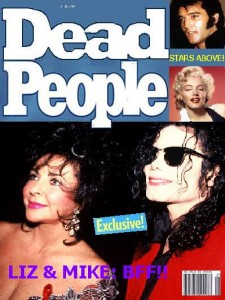 So what has Sylvia Browne got against the rich and famous? What have they ever done to her? In a previous book, she spilled the beans about what selected celebs are presently up to on the Other Side; and now, in her latest book, she exposes the dark secrets of their previous lives, secrets which they could reasonably have expected to live down by now.
So what has Sylvia Browne got against the rich and famous? What have they ever done to her? In a previous book, she spilled the beans about what selected celebs are presently up to on the Other Side; and now, in her latest book, she exposes the dark secrets of their previous lives, secrets which they could reasonably have expected to live down by now.
Again, Browne gets the goods straight from her spirit guide Francine, the 16th century Aztec/Inca woman from Colombia, apparently an incorrigible gossip. Francine, in turn, must be getting her info from the parchment scrolls in Heaven’s neoclassical Hall of Records, where all past lives are recorded in excruciating detail. From the samples given in this book, the parchment scrolls strongly resemble the slush pile of a really bad romance publisher.
Elizabeth Taylor, for example, spent her forty-seven previous lives swinging from spiritual to secular and back again, starting in 2nd century BC “Babylonia” as Anata, a deeply religious devotee of Hera and mother of four. Fast forward to the 1500s AD, where Marie Lilliane, neglected by her hedonistic parents, becomes a saintly Benedictine abbess devoted to the care of the elderly, orphans, and stray animals. Not surprisingly, her next life (in the 1700s) swings the other way: to Chantell, seductive courtesan at the court of Marie Antoinette, wooed by the fiery François (Mike Todd in a later life) and the brooding Arnaud (aka Richard Burton) until her beauty fades and she becomes a crazy cat-and-dog lady and dies alone of a burst appendix in her decrepit mansion. Happily, her latest incarnation as the divine Liz taught her all she needs to know about life, so she won’t have to come back again. After forty-eight lives, I should think that would be a relief.
Michael Jackson, on the other hand, was only incarnated nine times, and only in the most recent life did he manage to live past the age of fourteen – which, according to Ms. Browne, explains a whole lot about Michael Jackson. His first life, as the motherless son of a highly placed courtier in 1st century BC Burma, was a terrific tear-jerker – he desolated his father by dying at thirteen of a compromised immune system, but not before working out some fabulous dance moves.
And so it goes – on and on. If you’re not into mini-bodice-rippers and breathless melodrama, the cumulative effect of all these past lives actually makes pretty dull reading. So here are just a few highlights:
Mother Theresa was a close associate of the apostle Luke, ministering to the poor and needy and building up her own cult following, which sounds oddly familiar. Later, she was a leper.
John Wayne, a handsome gigolo in 1500s Spain, hanged himself after he was badly burned in a complex scenario involving a kidnapping and the Spanish Armada.
Donna Reed was an African slave.
Marlon Brando was a Tahitian noble, then a Salish brave.
Amelia Earhart spent fifteen of her fifty-two lives as men, including a gladiator, a Turkish warrior, and a Norwegian explorer.
Lucille Ball was a Scotsman named Albert.
Marilyn Monroe’s misadventures defy summarizing.
Whitney Houston witnessed the Crucifixion.
Joseph Campbell was Plato.
Steve Jobs was Galileo.
The really astonishing thing about this book, however, is the fact that I found it in the nonfiction section.
